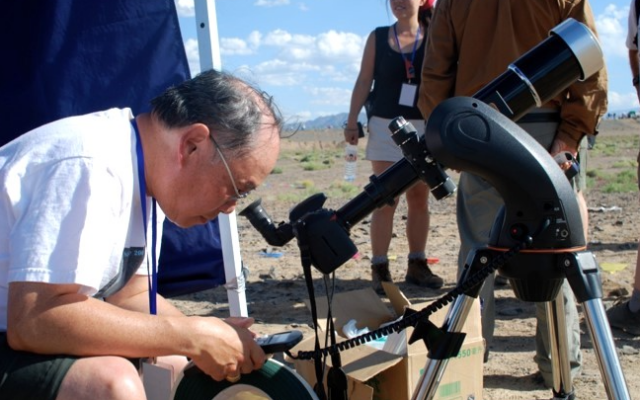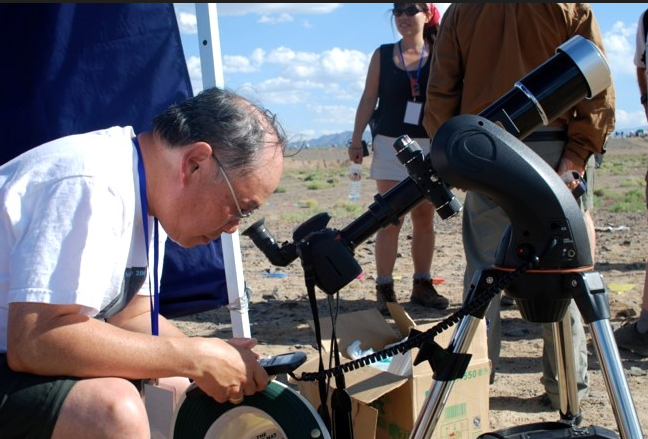
Protecting your eyes in a total eclipse is harder than it seems
By Kathleen Phalen Tomaselli, Houlton Pioneer Times Staff
As total solar eclipse fever heightens and chasers get ready to view a cosmic rarity, eye safety precautions can get pushed aside for more glamorous plans.
While everybody knows not to look directly into the sun, people will be tempted when a swath of Maine sees the historic eclipse on April 8. To view it safely, you need to have the right kind of safety glasses and be quick with them once totality ends, according to one expert
“There is the combination of not only the visual eclipse but all the other things that are going on around you that give you the pure glory of the eclipse,” said Ralph Chou, a retired professor at the University of Waterloo School of Optometry and Vision Science in Canada. “I have seen sane scientists lose their minds during totality. It is a cathartic reaction.”
Chou has spent several decades devoted to studying eclipse safety and is a self-proclaimed eclipse chaser. With 20 total solar eclipses notched on his belt, he’s seen the moon cross over the sun in China, Madagascar and Libya, to name a few. During that period, he has seen a lot of eye damage.

PREPARED TO VIEW — Eclipse chaser and eclipse eye safety scientist Ralph Chou watches an eclipse in Weizi Gorge in Xinjiang, China with a specially prepared solar viewing telescope.
The good news for Maine is that the April event will be in the late afternoon, so the eclipse is going to be lower in the western sky and not as dangerous as it would be at midday. The level of danger is still high but lower than if you were viewing in Texas at high noon, where he is planning on watching the spectacle.
There is a good chance that at least some people in Maine will have cloud cover at eclipse time. That may help filter the damaging light, but it is still not likely to be safe enough without appropriate protection.
“When you look at the sun and have a sense of dazzle or get an afterimage, it’s too bright,” he said.
While the evidence is hard to gather, during the 2017 total solar eclipse, at least 100 people along the path of totality in the U.S. and Canada experienced significant retinal damage from the sun, according to several studies and anecdotal reports.
In the time leading up to the event, whether in the totality zone or in areas seeing only a partial eclipse, eyes must be protected with certified eclipse viewers or No. 13 or No. 14 welder’s glass, he said.
About 15 or 20 minutes before the eclipse, the pupils will dilate completely to compensate as the overall illumination level darkens and at that point, Chou said at that point you suddenly become aware that the world is becoming dimmer. The wind picks up because the air in the total shadow area is cooling. Birds will start roosting.
The only people who can take the eye viewing filters away and look at the sun unprotected are those in the path of totality and during the two or three minutes of darkness. Those areas include Millinocket and Houlton. People viewing in partial eclipse areas are not safe at any time without eye protection.
As the moon crosses the sun, a crescent will appear. The first bright flash of light on the edge of the moon when the disc of the sun is starting to be uncovered is when it becomes dangerous again during totality.
“Similarly going in you will see the crescent start to break up into a series of points of light when those shrink down into one or two last little points of light you can remove the filter temporarily,” Chou said. “That’s when it’s safe.”
Think you are safe with a camera or telescope between you and the sun? You are not. Without filters on both the camera lens and the viewfinder, Chou said your eyes are at the same risk as viewing directly. The same goes for film medium format cameras.
The retinal burns from an eclipse generally are in a crescent shape in the middle of the eye, resembling the shape of the sun that was visible when the viewer looked at it without eye protection.
The damage is not immediate and it is not always permanent. Damaged retinal cells will continue to function for several hours after the damage and slowly die off during the night while sleeping.
Chou said many of his patients with eclipse retinal damage go to bed with fine vision. When they wake, they suddenly realize that there is a spot right in the center of their visual field where they can’t see detail.
The size of the damaged area may be enough that they look in the bathroom mirror and they can’t see part of their face or can’t see their face at all. Or they go downstairs to the kitchen to have breakfast and look across the table and can’t see a family member’s face, Chou said.
At that point there is no treatment for the damage and they just have to wait and see, he said.
“Those who present with a loss of vision the morning after the eclipse run a 50 percent chance of getting back their pre-injury level of vision,” Chou said. “At least several weeks or several months before one has any idea whether recovery is possible.”
Chou said younger people have larger pupils so children are a bit more vulnerable and the less pigment you have in your eyes, the more vulnerable. So blue-eyed people are more likely to be burned than someone with brown eyes, he said.
Even when you think you have taken the proper precautions, the eclipse viewers you purchased might be bogus, according to Chou.
Some Amazon vendors are submitting eclipse viewers to testing houses. When they get the report back, they are altering the results to make it look like the product has passed. Others run a bait-and-switch thing scheme in which they get a quality viewer tested and then sell an entirely different product, he said.
According to Chou, welding glasses work just as well as eclipse viewers. But he says to order now to make sure it arrives in time.
“You don’t get as sharp an image as eclipse viewers,” he said. “But it is a safe image. It looks bright green rather than a white or orange color the viewers provide.”